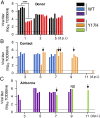Molecular requirements for a pandemic influenza virus: An acid-stable hemagglutinin protein
- PMID: 26811446
- PMCID: PMC4760800
- DOI: 10.1073/pnas.1524384113
Molecular requirements for a pandemic influenza virus: An acid-stable hemagglutinin protein
Abstract
Influenza pandemics require that a virus containing a hemagglutinin (HA) surface antigen previously unseen by a majority of the population becomes airborne-transmissible between humans. Although the HA protein is central to the emergence of a pandemic influenza virus, its required molecular properties for sustained transmission between humans are poorly defined. During virus entry, the HA protein binds receptors and is triggered by low pH in the endosome to cause membrane fusion; during egress, HA contributes to virus assembly and morphology. In 2009, a swine influenza virus (pH1N1) jumped to humans and spread globally. Here we link the pandemic potential of pH1N1 to its HA acid stability, or the pH at which this one-time-use nanomachine is either triggered to cause fusion or becomes inactivated in the absence of a target membrane. In surveillance isolates, our data show HA activation pH values decreased during the evolution of H1N1 from precursors in swine (pH 5.5-6.0), to early 2009 human cases (pH 5.5), and then to later human isolates (pH 5.2-5.4). A loss-of-function pH1N1 virus with a destabilizing HA1-Y17H mutation (pH 6.0) was less pathogenic in mice and ferrets, less transmissible by contact, and no longer airborne-transmissible. A ferret-adapted revertant (HA1-H17Y/HA2-R106K) regained airborne transmissibility by stabilizing HA to an activation pH of 5.3, similar to that of human-adapted isolates from late 2009-2014. Overall, these studies reveal that a stable HA (activation pH ≤ 5.5) is necessary for pH1N1 influenza virus pathogenicity and airborne transmissibility in ferrets and is associated with pandemic potential in humans.
Keywords: fusion glycoprotein; influenza virus; membrane fusion; pandemic; transmission.
Conflict of interest statement
The authors declare no conflict of interest.
Figures





References
-
- Krauss S, Webster RG. Avian influenza virus surveillance and wild birds: Past and present. Avian Dis. 2010;54(1) Suppl:394–398. - PubMed
-
- Elderfield R, Barclay W. 2011. Influenza pandemics. Adv Exp Med Biol 719:81–103.
-
- Smith GJ, et al. Origins and evolutionary genomics of the 2009 swine-origin H1N1 influenza A epidemic. Nature. 2009;459(7250):1122–1125. - PubMed
-
- Belser JA, Maines TR, Tumpey TM, Katz JM. Influenza A virus transmission: Contributing factors and clinical implications. Expert Rev Mol Med. 2010;12:e39. - PubMed
Publication types
MeSH terms
Substances
Grants and funding
LinkOut - more resources
Full Text Sources
Other Literature Sources
Research Materials
Miscellaneous

